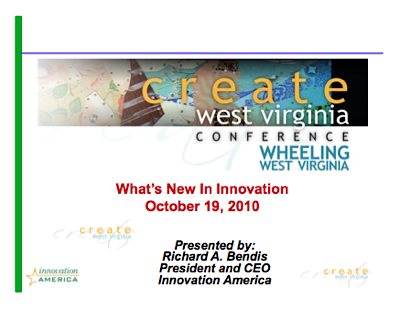 During the Clinton presidency democratic strategist James Carville, was fond of saying, "It's the economy, stupid."
During the Clinton presidency democratic strategist James Carville, was fond of saying, "It's the economy, stupid."
Much the same could be said today.
The stimulus and all the federal policies in the world will not help if all we do is prop up the old economy. It is rather the new economy, the creative economy begging for attention.
John Howkins, author of The Creative Economy (2001), says that anyone with a good idea can make money. He defines creative industries as occupations like advertising, architecture, graphic design, filmmaking, authors, painters and the like which you can count in the few millions. Richard Florida, author of The Rise of the Creative Class (2004), claims 38 million people as among the new creative class.
innovation DAILY
Here we highlight selected innovation related articles from around the world on a daily basis. These articles related to innovation and funding for innovative companies, and best practices for innovation based economic development.
Five commons myths about entrepreneurship
 There’s a great story you may have heard about a PhD student from a few years back at University of Toronto.
There’s a great story you may have heard about a PhD student from a few years back at University of Toronto.
It goes something like this: Every day at lunch, starting in the late spring, the student would walk out onto the football field. He’d bring a large bag of birdseed and a whistle. He’d spread birdseed all over the field. After 20 or 30 minutes, he’d blow the whistle. At first, a few birds would respond to the noise and drop in for some seeds. But gradually, over the course of the summer, more and more birds would descend on the field, expecting to be fed. Then the first football game of the autumn rolled around, the players lined up, the referee blew the whistle, and …
A New Model for Predicting Social Media Impact
 What's social media good for? Marketers see it as a new way to engage with consumers. Economist-turned-advertising executive Jason Harper sees an additional function: as a real-time laboratory for measuring how multi-million dollar ad campaigns are succeeding or failing to drive product sales.
What's social media good for? Marketers see it as a new way to engage with consumers. Economist-turned-advertising executive Jason Harper sees an additional function: as a real-time laboratory for measuring how multi-million dollar ad campaigns are succeeding or failing to drive product sales.
Armed with a masters degree in applied economics, Harper was hired three years ago, at age 30, by the Detroit office of Organic Inc., a leading digital ad agency, to crunch the ad campaign data of car companies -- with the goal of seeing whether digital marketing efforts were helping move vehicles off lots. Assigned to Chrysler's Jeep and Dodge Ram truck accounts, Harper had to figure out how to correlate whether TV commercials were driving website visits, Twitter conversation and Facebook brand page activity. He also had to calculate whether all that online activity was leading to an increase in test drives at dealerships. "The biggest question with social media is 'what's the value?'" he says.
Create W.Va. Forum Closes
 WHEELING - West Liberty University President Robin Capehart and Huntington-based hip-hop artist K-Kutta come from different backgrounds, but both believe entrepreneurship is key to West Virginia's future.
WHEELING - West Liberty University President Robin Capehart and Huntington-based hip-hop artist K-Kutta come from different backgrounds, but both believe entrepreneurship is key to West Virginia's future.
"We need job creators. We need people that have the will to go out and take a risk, like these gentleman have done," Capehart said of Kutta and Luke Glass, vice president of Morgantown-based ListHub.net, during the final day of the 2010 Create West Virginia conference Tuesday at Oglebay Park's Wilson Lodge.
Folks from all over West Virginia came to the Wheeling conference to help find ways to develop the state's new economy.
During the Tuesday panel discussion regarding the benefits of starting new businesses in the Mountain State, Capehart said West Liberty is making a commitment to ensuring students realize they do not have to work for someone else when they graduate.
Bendis' Presentation
Generating buzz for your venture: 43 bits of free advice from entrepreneurs, PR peeps, and journos
 Understanding how to generate buzz is a crucial entrepreneurial skill — especially for ventures that haven’t raised jillions of dollars to spend on advertising or giant trade show booths. At last week’s MassTLC Innovation Unconference, a group of PR pros, journalists, social media experts, and entrepreneurs got together to collaboratively create this list of 43 ways to generate buzz in both traditional media and social media. It’s not a definitive list by any standard, and I don’t agree with 100 percent of it, but it collects a number of perspectives about how to get free ink for your company.
Understanding how to generate buzz is a crucial entrepreneurial skill — especially for ventures that haven’t raised jillions of dollars to spend on advertising or giant trade show booths. At last week’s MassTLC Innovation Unconference, a group of PR pros, journalists, social media experts, and entrepreneurs got together to collaboratively create this list of 43 ways to generate buzz in both traditional media and social media. It’s not a definitive list by any standard, and I don’t agree with 100 percent of it, but it collects a number of perspectives about how to get free ink for your company.
I’ve edited the original list to try to make it more useful than the rough notes from the session (which were kindly taken by Richard DiBona of Episend), and added some advice that I found myself dispensing after the session to people who stuck around. When I recall who made a given point, I’ve attributed it.
1. Know what your message is. What is important about your company and how are you going to talk about it? Have a brainstorming session to talk about how best to present your story.
16 Lbs. of Solid Iron Innovation
 Ever want to throw a shot put into the middle of an intransigent organization or system? I know I have. With a shot put weighing in at 16 pounds most of us had better either be very close to the target or consider a better way to catalyze change.
Ever want to throw a shot put into the middle of an intransigent organization or system? I know I have. With a shot put weighing in at 16 pounds most of us had better either be very close to the target or consider a better way to catalyze change.
You probably haven’t heard of James Fuchs, who passed away on October 8, but he was a classic innovator. Fuchs was the best shot-putter in the world from 1949-1950. He won 88 consecutive meets, set four world records, and changed the sport forever. Fuchs teaches us about the difference between best practices and next practices.
Fuchs was a fullback on the Yale football team but injuries kept him from playing. He was also on the track team and while recovering from surgery for a leg injury he was limited to competing in discus and shot put. Fuchs became best known for shot put. Fuchs’ leg injury prevented him from using the standard and universally accepted shot put technique. State of art at the time was for a shot-putter to come to a complete stop before releasing the shot. Before Fuchs, shot put was all about brute arm strength. Athletes focused their training on weight lifting. All shot putters competed on a model of arm strength equals distance. That is until James Fuchs came along. Fuchs didn’t lift weights at all and weighed only 215 pounds, small for a shot putter.
The Future of Television & The Digital Living Room
 Dana Settle & I are hosting a dinner tonight (10/20/10) with some of the biggest companies in entertainment to talk about the future of television, film & digital media. Michael Ovitz, the co-founder of CAA will be the keynote speaker.
Dana Settle & I are hosting a dinner tonight (10/20/10) with some of the biggest companies in entertainment to talk about the future of television, film & digital media. Michael Ovitz, the co-founder of CAA will be the keynote speaker.
Nobody can predict 100% what the future of television will be so I won’t pretend that I know the answers. But I do know that it will form a huge basis of the future of the Internet, how we consume media, how we communicate with friends, how we play games and how we shop. Video will be inextricably linked to the future of the Internet and consumption between PCs, mobile devices and TVs will merge. Note that I didn’t say there will be total “convergence” – but I believe the services will inter-operate.
Innovation Nation?
 As a whole, manufacturing industries operating in the United States are more engaged in innovation than their non-manufacturing brethren. So suggest preliminary data from the National Science Foundation, an independent U.S. government agency that promotes science and engineering.
As a whole, manufacturing industries operating in the United States are more engaged in innovation than their non-manufacturing brethren. So suggest preliminary data from the National Science Foundation, an independent U.S. government agency that promotes science and engineering.
At least such was the case between 2006 and 2008, the period addressed by the NSF research. Survey data show that about 22% of manufacturers introduced product innovations (defined as one or more new or significantly improved goods or services), compared with 8% of companies in non-manufacturing sectors. The same held true for process innovation: About 22% of manufacturers introduced process innovations compared with 8% of non-manufacturers. (The data are courtesy of the NSF's Business R&D and Innovation Survey, fielded for the first time in 2009. Manufacturers comprised 8% of the 1.5 million for-profit firms represented.)
Germany’s Technology Aims Higher With Venture Capital Investments
 With its famed history as a premiere world leader in technological innovations, Germany is looking to add to its already stellar reputation. After establishing benchmark standards in automotives, machine tools, telecommunications, biotechnology, pharmaceuticals and wind turbines; Germany is taking steps toward becoming a global innovator in the development of solar power and other environmental technologies.
With its famed history as a premiere world leader in technological innovations, Germany is looking to add to its already stellar reputation. After establishing benchmark standards in automotives, machine tools, telecommunications, biotechnology, pharmaceuticals and wind turbines; Germany is taking steps toward becoming a global innovator in the development of solar power and other environmental technologies.
German venture capital investments in clean technology have dramatically increased in recent years and haven’t shown any signs of slowing down. Just recently two German state funds of funds, the ERP-EIF Fund of Funds and the LfA-EIF Fund of Funds, have joined U.K based WHEB ventures by investing £21m between them and expanding its offices to Munich. Funds of funds, also known as FoF - are investment funds that use a diversified portfolio in their strategy, rather than investing directly in one type of fund, such as shares, bonds or other securities. This type of investing is often referred to as multi-manager investment.
Sir Ken Robinson: A Creative Education
Do schools kill creativity? Sir Ken Robinson asked that question at the 2006 TED conference. And the talk resonated widely. His short presentation remains one of the most watched and “favorited” videos in TED’s large catalogue of inspiring videos. Quite an accomplishment.
Now, with the latest RSA video, Sir Ken returns to delve deeper into this basic question. He asks, Why do schools kill creativity? And why is this problem built into the modern educational system? And how can we bring a “paradigm” shift – one that will let schools foster creativity at long last?
NIST Releases 2009 Department of Commerce Technology Transfer Report
 The National Institute of Standards and Technology (NIST) has released the 2009 Technology Transfer Report, an annual report summarizing the technology transfer activities and achievements of the U.S. Department of Commerce's scientific research agencies, including NIST, the National Oceanic and Atmospheric Administration and the National Telecommunications and Information Administration's Institute for Telecommunication Sciences. In addition to performance metrics, the report features anecdotes that demonstrate how investment in research and development improves the lives of American citizens and spurs the development of new products.
The National Institute of Standards and Technology (NIST) has released the 2009 Technology Transfer Report, an annual report summarizing the technology transfer activities and achievements of the U.S. Department of Commerce's scientific research agencies, including NIST, the National Oceanic and Atmospheric Administration and the National Telecommunications and Information Administration's Institute for Telecommunication Sciences. In addition to performance metrics, the report features anecdotes that demonstrate how investment in research and development improves the lives of American citizens and spurs the development of new products.
Technology transfer is an essential mission of federal laboratories that leverages the creative intellectual capital of government scientists and the nation's investments in science and technology to strengthen the American economy and the nation's ability to compete in world markets.
Buzz builds for Ohio State University venture-capital fund
 A lofty idea to create a $100 million-plus venture-capital fund is gaining momentum, even though college leaders have just started tossing around the notion.
A lofty idea to create a $100 million-plus venture-capital fund is gaining momentum, even though college leaders have just started tossing around the notion.
"Sometimes, all it takes is a great idea," Ohio State University spokeswoman Shelly Hoffman said yesterday.
Higher-education officials have been buzzing about the idea this week since OSU President E. Gordon Gee told a newspaper that he'd like to see the state's public schools partner with private businesses to move more research discoveries into the marketplace. Venture-capital funds invest in new ideas in the hope of gaining big returns.
Gee's comments to the Dayton Daily News made the idea public, but Ohio State officials have been vetting the possibility on the sly for the past several months.
"I've been talking to a number of people in Columbus and throughout the state quietly about the idea, at least until yesterday," OSU Chief Financial Officer Geoffrey S. Chatas said with a laugh. "I'm glad to see that Gordon apparently likes the idea."
Chatas, a former JPMorgan Chase executive, joined Ohio State in February partly to help the university jump-start its effort to bring faculty inventors and businesspeople together to turn ideas into money and jobs.
University Startups Conference 2010 (Bendis to Speak)
Only 15 University Sponsor Slots Left!
Register at www.ncet2.org
___________________________________________________
The University Startups Conference will take place December 1-3, 2010 at the Washington Convention Center, Washington, DC.
The University Startups Conference is a unique conference series dedicated exclusively to creating and funding university startups. We bring together universities creating startups with VCs, angel investors, Federal Government program managers and Fortune 500 companies that fund them.
The Conference is organized annually by the National Council of Entrepreneurial Tech Transfer (NCET2.org). This year's University Co-Hosts are the University of Maryland and Boston University. The Government Co-Hosts are the National Science Foundation (Division of Industrial Innovation and Partnership) and National Institutes of Health (Office of Tech Transfer). The Embassy Host is the British Embassy. The venture capital sponsors are the National Venture Capital Association (NVCA) and the National Association of Seed and Venture Funds (NASVF).
For more information please click here.
The Future-Proof Entrepreneur: 25 New Tech Trends
 Pesky thing, tomorrow. Day after day, it shows up and brings technological innovation that alters the best-laid plans of every business owner.
Pesky thing, tomorrow. Day after day, it shows up and brings technological innovation that alters the best-laid plans of every business owner.
Managing for the future isn't easy. Emerging technologies and new developments can create a tumbling mash-up of hard-to-understand products and services, from web-connected printers to robots that represent you in meetings. And some innovations are even harder to get your head around--like an internet that thinks on its own and actually does some of your work for you. (No kidding, that's coming.)
To keep you sane--and to try to help you get some sleep at night--here is our list of the top 25 tech tips, trends and megatrends: what's new now, what will be new tomorrow and what you can expect to grapple with even farther down the road.
The Value of An Existing Customer: High (Infographic)
Conventional wisdom dictates that existing customers are valuable, but sometimes that wisdom becomes the baby tossed out with its bathwater when customer acquisition hikes its way up the priority list. Social media marketing service Flowtown (our review) thought it would be interesting to see just how valuable those customers are, so they put together some noteworthy data summaries.
The takeaway? Don't toss the baby. It's your moneymaker.
Flowtown's chart argues that not only do loyal customers give businesses a competitive edge, but they can be pretty profitable (especially when you factor in the cost of new customers, which can be 6-7% higher than your existing base). It's a sentiment that's being felt all-around especially when companies like AmEx tell us they see entrepreneurs shoring up losses by engaging with, retaining, and reaping the rewards of mining existing customers.

Air Power: The Making of a Modern Wind Turbine and Wind Farm
 In the past decade the amount of electricity produced by harnessing the wind in the U.S. has grown 13-fold, now supplying some 2.3 percent of U.S. electricity needs, or enough juice to power the state of Wisconsin. Wind turbines have been rising above the plains in Texas, cropping up on ridge lines in Oregon and even threatening to appear offshore in Massachusetts's Nantucket Sound—all to take advantage of the uneven heating of Earth's surface that creates air currents, or wind.
In the past decade the amount of electricity produced by harnessing the wind in the U.S. has grown 13-fold, now supplying some 2.3 percent of U.S. electricity needs, or enough juice to power the state of Wisconsin. Wind turbines have been rising above the plains in Texas, cropping up on ridge lines in Oregon and even threatening to appear offshore in Massachusetts's Nantucket Sound—all to take advantage of the uneven heating of Earth's surface that creates air currents, or wind.
4 Ugly Truths About Selling Your Business They Don’t Teach You at Harvard
 Full disclosure: This post is not for everyone. There are a lot of great reasons to build a business of your own, including providing much-needed jobs, giving back to your community, building a legacy for your kids to inherit or making a difference in some other way. But if these are your business goals, move on to read something else; this post will only frustrate you. If you see your business as an extension of your personality or a creative expression, keep creating and stop reading.
Full disclosure: This post is not for everyone. There are a lot of great reasons to build a business of your own, including providing much-needed jobs, giving back to your community, building a legacy for your kids to inherit or making a difference in some other way. But if these are your business goals, move on to read something else; this post will only frustrate you. If you see your business as an extension of your personality or a creative expression, keep creating and stop reading.
If, however, you are Machiavellian in your attitudes and see business as a way to generate money so you can have the freedom to do other things with your time, this post is for you. Think of it as a cheat sheet of sorts — the four ugly truths you need to know about selling your business that you won’t learn at Harvard, or any other MBA program.
New York and the Regional Energy Innovation Cluster (E-RIC)
 This article is the second in a two-part series detailing two proposed regional innovation clusters whose collaborators remain committed to the goals and objectives outlined in their E-RIC proposals. The $129.7 million federally-funded Energy Regional Innovation Cluster (E-RIC) grant, which was awarded to the Greater Philadelphia Innovation Cluster (GPIC) in August, required applicants to complete a five-part application package. Although DOE awarded E-RIC dollars to only one of 12 applicants, the process yielded results for other participating consortia.
This article is the second in a two-part series detailing two proposed regional innovation clusters whose collaborators remain committed to the goals and objectives outlined in their E-RIC proposals. The $129.7 million federally-funded Energy Regional Innovation Cluster (E-RIC) grant, which was awarded to the Greater Philadelphia Innovation Cluster (GPIC) in August, required applicants to complete a five-part application package. Although DOE awarded E-RIC dollars to only one of 12 applicants, the process yielded results for other participating consortia.
Our first article, included in the September 2010 edition of the Site Selection Energy Report, spotlighted New England’s proposed clean energy innovation cluster consortium and the region’s intentions to advance aspects of its proposal post-E-RIC. This article examines the federal government’s approach to cluster development as well as aspects of the New York E-RIC (NYE-RIC) and its collaborators’ efforts to pursue opportunities revealed during the proposal process.
How to Discover the 99 Percent of Jobs You've Never Heard Of
 You’ve passed every biology quiz that’s been put in front of you and learned to whip through a French history paper or a set of calculus problems, but there is one question that still bedevils a lot of recent college graduates — what are you going to do now?
You’ve passed every biology quiz that’s been put in front of you and learned to whip through a French history paper or a set of calculus problems, but there is one question that still bedevils a lot of recent college graduates — what are you going to do now?
The obvious answer is get a job, but which job? From family, friends and TV characters, you probably know the standard doctor, lawyer and police investigator, but according to Matt Mahoney, founder of site Daily Endeavor, there are actually something in the neighborhood of 250,000 jobs out there. One of those may be perfect for you you, but how do you find out about it?


 Is PR
Is PR 